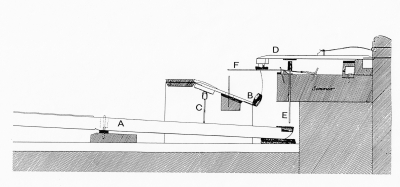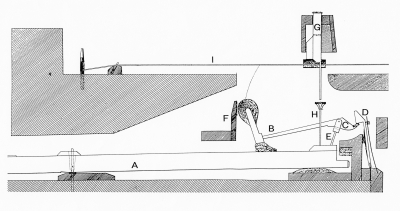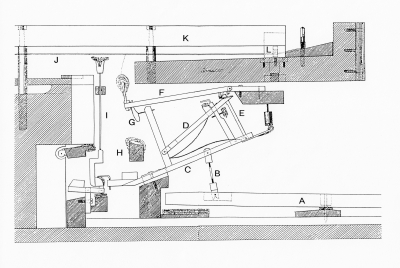The Piano of the First Half of the Nineteenth Century
Vienna continued to be a leading piano making center in Europe. Among a few hundred workshops, concentrated mainly in the Austrian capital, such excellent makers as Anton Walter, Johann Schantz, the Stein-Streicher family, Matthias Müller, Conrad Graf and many others were active. Their instruments underwent successive transformations, however maintained the constructional and sound characteristics that made them different from pianos made elsewhere. The keyboard compass was gradually extended from five to five-and-a-half octaves after 1810, and six and a half after 1820. The old keyboard coloring (naturals dark, sharps bright), taken after the harpsichord, was abandoned and the layout used now emerged. The enlarged case measured in the 1820s up to about 250 cm in length and 125 cm in width, but it retained the old lightness of its silhouette. Gradually, its construction was strengthened as a heavier string set was being introduced (compass extension and overspun bass strings – still not very common). In 1833, Johann Baptist Streicher patented the compensating frame tubes, and in 1839 Friedrich Foxa – the metal frame. After 1810 pedals replaced knee levers.
However, comparing to the English pianos, all of these innovations were a dozen or more years late. The action itself underwent only small transformations, yet its size and weight rose gradually, which later resulted in the limitation of its efficiency in fast repetitions. In Stein-Streicher’s and their followers’ actions the metal hammer fork (Kapsel) and the back-check, adopted from A. Walter, were introduced, which further unified the Viennese action (see Fig.2). At the same time, down-striking actions (first patented by J. B. Streicher in 1823) and single English actions with a single escapement appeared, bringing together elements of the Viennese and English actions (also patented by J. B. Streicher in 1824 and 1831). The latter gained great popularity in the Viennese centre. Yet, as one of the cheapest, Stein’s action was used most often, practically till the end of the 19th century, and in some firms even till World War I. Thanks to their sound (a singing, soft, round tone) and technical distinctiveness (light and shallow touch), Viennese pianos enjoyed popularity until the middle of the century. After 1850, when the improved English action and English piano construction prevailed, they became a regional anachronism only.
The English pianos were domains of the British and French makers, joined around 1850 by the Americans and later the Germans. The imperfections of the 18th century English action, compared to the Viennese one, forced constructors to look for new solutions. The instrument itself was becoming bigger and more solid. Gradually, the metal gap spacers, frame tension bars and case braces were introduced, which made it possible to increase the strings’ thickness and tension, apply bigger hammers and obtain a more voiced tone. As early as at the end of the 18th century, the small metal braces (gap spacers) between the wrest plank and the case’s belly rail appeared. There were attempts to replace the instrument’s wooden internal structure with a metal one as well. In 1799 J. Smith patented such a metal structure. Yet continuous attempts to fit metal braces under the soundboard could not compensate for the strings’ increased tension. In 1808, Broadwood used metal frame tension bars for trebles. In 1821, he already used 3-5 frame bars. From 1820, Stodart applied a compensation frame (invented and patented by his employee Thom and Allen), composed of 13 brass, iron longwise tubes and 4 wooden crossbars. Then, in 1827, J. Broadwood patented iron bars combined with a metal string plate (hitch pin plate). This type of composite frame was used in the whole Europe till the whole-metal frame spread.
Enlarging the instrument was followed by increasing the strings’ mass, which required increasing the hammers’ and their coverings’ mass. With more and more leather layers covering the hammerheads, they could not serve their purpose while striking more tense, thicker strings and string choirs. In 1826, Henry Pape patented hammer felt and its production in France. As its technology improved, its use was getting more common, until it prevailed over the other covering types in the second half of the century. More conservative Viennese makers covered felt hammer heads with an additional layer of leather, which corresponded with the lighter strings applied by them. A bigger and heavier hammerhead needed a thicker and longer hammer shank, which led to the further increase of the weight of whole action. It limited its technical efficiency. Hence the action with double escapement patented by Erard in 1821 was so important. Single and double repetition actions (introduced by various makers) improved the fast repetition of notes in English actions. Erard’s action proved to be the best, and is used till today in a modified form. Other improvements of those days were, e.g. agraffes patented by Erard in 1808, preventing strings from shifting and clattering against the nut during playing. A similar function in relation to the treble strings (sometimes for all strings) was served by the harmonic bar, pressure bar or capo tasto (a V-shaped bar pressing the strings) patented later by various makers. Other innovations were borrowed around the mid-19th century from square pianos, which were improved in an attempt to match grand pianos’ technical capabilities and sound power.
Instruments used mainly at home and assigned to smaller rooms can be called study or boudoir instruments. In the 19th century, as in the preceding century, square pianos belonged to the most popular interments of the type, and their production reached 80% of the global output. During the first half of the 18th century they retained their popularity in most of the countries, the longest in Germany and Sweden (till c.1860) as well as in the USA (almost until the end of the century, when they were equal in size to grand pianos and stopped to be study instruments). Square pianos grew gradually larger. Comparatively early, the metal hitch-pin plates and braces were adopted in their production. These instruments had the first one-piece cast-iron frames, one of the main constructional element of today’s pianos. Alpheus Babcock in Boston was the first to patent such a frame for the square piano in 1825. Next patents belonged to H. Pape in 1826 and another Parisian, G. Petzold in 1829. Not before 1843, J. Chickering in Boston patented the first one-piece iron frame for the grand piano. The precedence of square pianos was probably a consequence of the square shape being less challenging than triangle for constructors to work with. Not without significance were also the troubles with casting technology (frames often cracking), because grand pianos required much larger and more resistant frames. Constructional and technological improvements enabled a more general use of cast-iron frames in grand pianos from the mid-19th century (first in the USA). The best form among the vertical pianos – the upright piano (pianino), supplanted square pianos.
Before, they had competed with upright piano’s predecessors, which were not less popular than square pianos. The already mentioned 18th century pyramid piano was the first of them. It was made mainly in Germany, in the first decades of the 19th century as well. From the turn of the centuries, vertical pianos’ development went in two directions: 1. to adapt the horizontal piano to the vertical position; 2. to redesign the vertical instrument to obtain smaller dimensions and to match horizontal pianos’ technical and sound efficiency. In 1795, William Stodart of London patented an upright grand piano in a bookcase form, with a vertically placed grand piano and bookshelves fitted in the string-free space. William Southwell, a Dubliner who settled in London, patented in 1798 a vertical square piano, and in 1807 – a cabinet piano. The latter had the wrest plank placed at its highest point, far from the keyboard. Its hammer action, also placed high, had to be linked with the keyboard by long wooden rods (so-called sticker action). Cabinet pianos gained big popularity in the first half of the 19th century, especially in England and France (made till c. 1860). Other vertical forms, named after the case shape, reigned in the German-speaking territories. In the first half of the 19th century, the lyre piano was made in Austria. Its invention is attributed to Vienna’s Joseph Wachtl and Jacob Bleyer. Simultaneously, the pyramid piano was replaced by the lyre piano in Berlin, designed in 1820 by Johann Christian Schleip. Lyre pianos were made in France and England, too. In the lyre piano, as in the pyramid piano, an oblique stringing was applied. The other characteristic feature of the vertical pianos in the German-speaking countries was the use of additional mechanical sound stops, mainly percussive (a drum, cymbals, triangle or bells, and bassoon) and a moderator, employed to perform the then popular Turkish marches. They were applied, though for a little shorter time, in grand pianos as well.
All the above mentioned vertical piano forms had a common feature: the greater part of the frame with the stringing set over the keyboard, which considerably increased the instrument’s full height, reaching from 200 to about 275 cm. Simultaneously, the case’s part under the keyboard level was unused and often replaced with high legs. Therefore, constructors following the second of above-mentioned trends in the upright piano’s development lowered the frame with the stringing to the floor level, with the wrest plank in the upper part (like in the cabinet piano). In 1800, Matthias Müller in Vienna made the so-called Ditanaklasis, which was about 154 cm high. In the same year, Isaac Hawkins of Philadelphia patented a portable grand pianoforte based on a similar constructional principle, and measuring 138 cm. These first upright pianos had vertical stringing. When their height was reduced, their stringing had to be shortened as well, which reduced the bass strings’ volume. They partly recovered their length thanks to oblique stringing, like in pyramid and lyre pianos. First patents belonged to Londoners: Thomas Loud in 1802 and Robert Wornum in 1811. However, not all saw the advantages of oblique-strung instruments, and both types of stringing were used in upright pianos till the second half of the century. Overstringing (cross-stringing) patented in 1828 by H. Pape and later by other makers was the next stage. It made it possible to shorten upright pianos even to 100 cm. Yet, cross-stringing did not spread before the second half of the century together with cast-iron frames.
Vertical stringing needed a proper hammer action. In high instruments, the Viennese and English action with a single escapement was adopted. However, these actions were less efficient here than in horizontal instruments. The problem of hammers returning faster to the initial position after hitting the string was solved by R. Wornum through the tape-check action, used by him as early as about 1837, and patented in 1842. This system became the principle of today’s upright piano’s action (Wornum applied it in grand pianos as well). The upright piano gained popularity not only in England but also in France, where it superseded square pianos already at the end of the 1830s. The name pianino (Italian: a small piano) was given to it in 1815 by a French producer, Camille Pleyel, whose constructions won followers also among Austrian and German music lowers and makers.
The piano earned general recognition by the turn of the centuries, thanks its distinct sound and constructional autonomy, as well as to its universality. It replaced completely the harpsichord in all forms of musical activity, the latter beginning to be discovered again at the end of the 19th century. There was no instrumental or instrumental and vocal performance without a piano, and no private music making without this instrument, whose popularity outshone the other used at home or in salons. Numerous piano-playing schools and piano-playing styles came into being, and composers and virtuosos, supported by piano makers, tried to explore the instrument’s potentialities to a maximum.
This process was followed by transformations in the instrument’s production process. It was still anachronistic compared to the technical progress happening in the other fields. Even in England, the cradle of industrialization, pianos were still handmade. The first half of the 19th century brought only minimal changes in this respect. The larger plants were still manufactories, where numerous craftsmen made instruments from end to end at a single workbench. It was so in the whole Europe. As the piano’s construction became more complicated and different materials and technologies were used, the need for specialization appeared, especially as regards the production of metal parts (strings, tuning pins, metal frame sections). To making increasingly longer series of instruments and satisfy the growing demand, producers had to apply the division of labor and employ qualified craftsmen: joiners (piano cases), varnishers (varnishing) and others. Till then, all these jobs were done by the piano maker. With a larger-scale production came the mechanizing of the production process: applying auxiliary machines borrowed from other trades or constructed specifically for the piano industry. The accumulation of all these processes took place by the mid-19th century. Yet, it was not the old continent, with its existing piano making centers (England, France, Austria), but North America that became the cradle of the instrument’s production revolution.
Professor Benjamin Vogel

Fig. 1. English single action without escapement and with lever dampers
A – key lever
B – hammer
C – jack
D – damper
E – damper stick
F – string

Fig. 2. Viennese action with single escapement and rack dampers
A – key lever
B – hammer
C – hammer tail (beak)
D – escapement
E – kapsel (fork)
F – back-check
G – damper
H – damper stick
I – string

Fig. 3. English double action with double escapement (S. Erard, 1821) and underdampers
A – key lever
B – first jack
C – intermediate lever
D – repetition lever
E – second jack
F – hammer
G – back-check
H – hammer rest
I – damper
J – string
K – frame stress bar
L – agraffe

Fig. 4. A grand piano composite frame after J. S. Broadwood’s patent from 1827
A – rest pin block (pinning table)
B – stress bar





